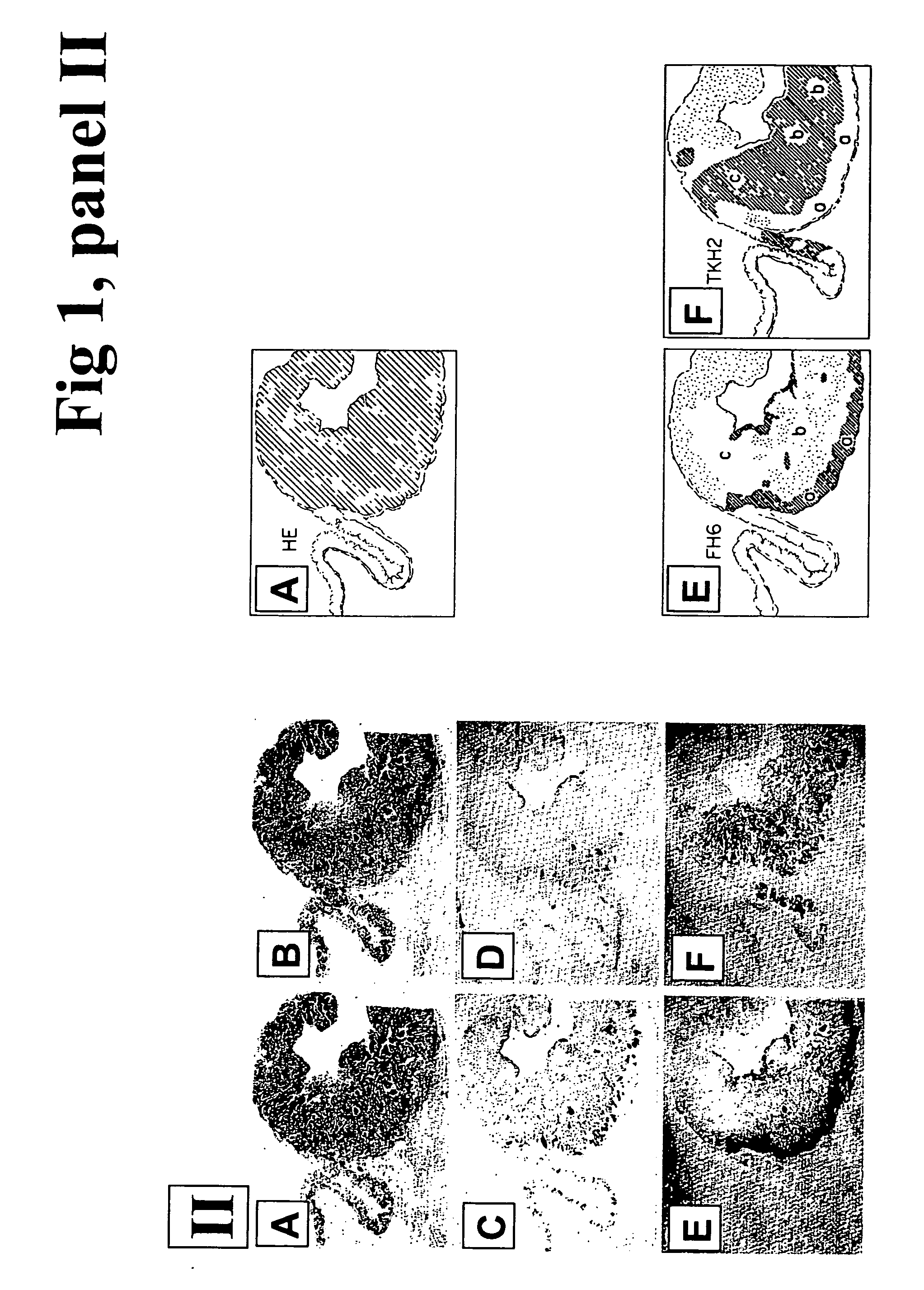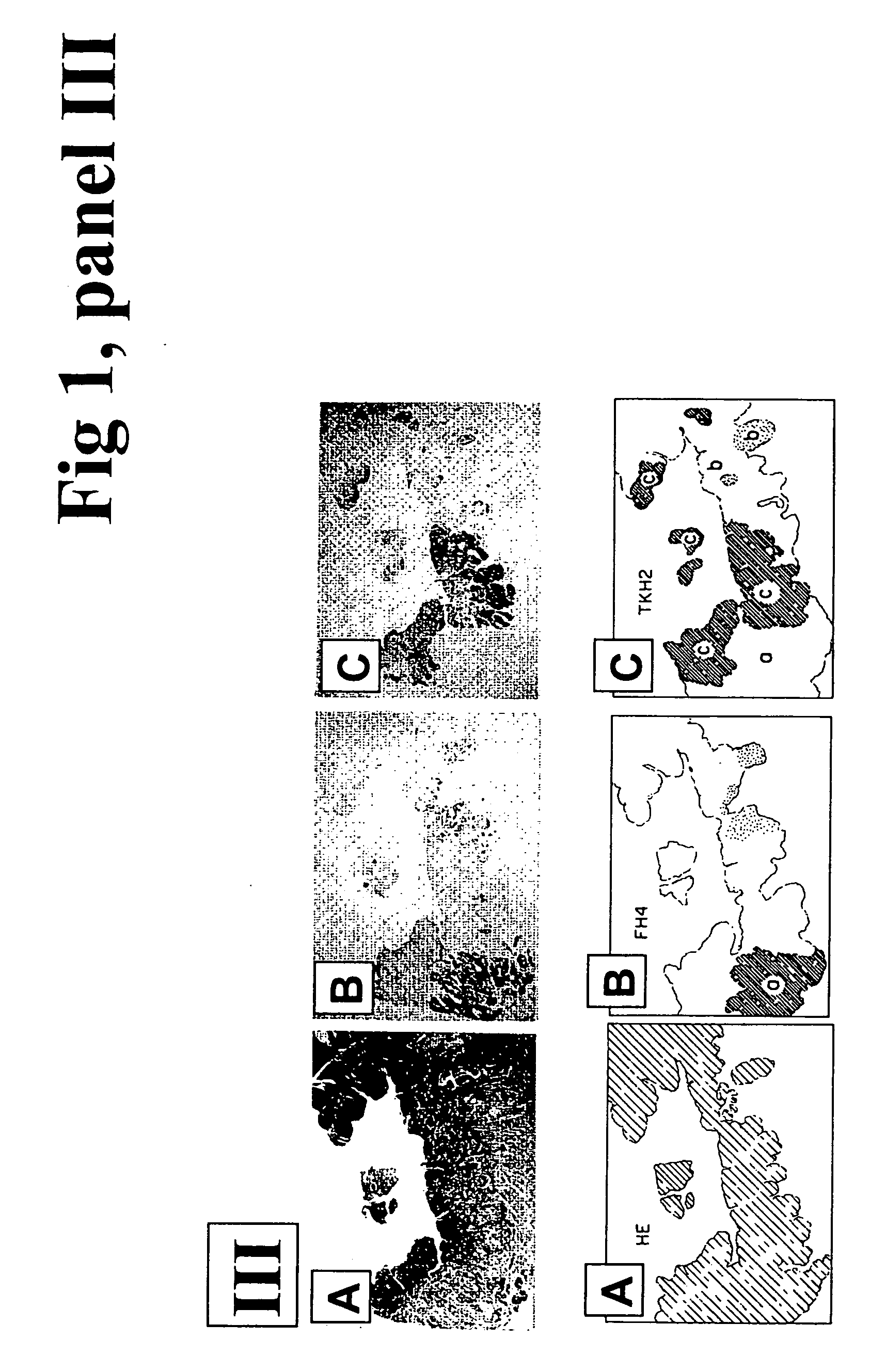Surface plasmon resonance biosensor system for detection of antigens and method for determining the presence of antigens
a biosensor and surface plasmon technology, applied in the field of surface plasmon resonance biosensor system for detection of antigens and method for determining the presence of antigens, can solve the problems of insufficient diagnosis insufficient detection of single tumor-associated antigen, and inability to detect multiple antigens within a single sample,
- Summary
- Abstract
- Description
- Claims
- Application Information
AI Technical Summary
Benefits of technology
Problems solved by technology
Method used
Image
Examples
example 1
Multiple Antigens Expressed in Different Loci of a Single Primary Human Tumor (“Mosaicism”)
[0057]FIG. 1 demonstrates that one locus of a tumor is stained by one monoclonal antibody (mAb), a second locus is stained by a different mAb, a third locus is stained by a different mAb, etc. Such a mosaic pattern may change depending on the stage of differentiation and tumor progression. This demonstrates the importance of determining the presence of multiple antigens in a sample from a single cancer patient, making SPR analysis particularly desirable for cancer diagnosis and prognosis.
[0058]FIG. 1, Panel I. Example of primary colonic cancer. (A) Hematoxylin / eosin staining. (B) Lex staining by mAb SH1. (C) Sialyl dimeric Lex staining by mAb FH6. (D) Sialyl-Tn staining by mAb TKH2. The entire tumor section was stained by SH1; some areas were stained strongly (area b) and others relatively weakly (area a) (right, B). Some areas (a) weakly stained by SH1 were strongly stained by TKH2, whereas...
example 2
Compact SPR Biosensor System
[0061] An angle-modulated compact SPR biosensor system in Kretschmann configuration is exemplified in FIG. 3. A He-Ne laser or laser diode serves as a monochromatic light source. A polarizer permits the p-polarized light to pass through, and a lens is used to adjust the light beam. A dove-type or semi-cylindrical glass prism serves as a Kretschmann attenuated total reflection (ATR) coupler. The reflected light is focused on a high resolution photodiode array or CCD camera. A digital window is placed in the illuminating arm to permit the light beam to be shed on a certain channel on the sensor chip. A disposable sensor chip is placed in a sample cassette, and the cassette holding the sensor chip is then inserted into the sample holder. The sensor chip is attached over the prism with a refractive index matching liquid, or polymer film applied between them (sensor chip and the prism).
Example 3
Detection of CEA With An SPR Biosensor
[0062] The SPR system of...
example 3
Basic Concept and Assembly of Self-Referencing SPR System
[0084] As illustrated in FIG. 3, a SPR biosensor monitors the refractive index change due to the interaction between a ligand and corresponding analyte, such as antibody and antigen. The refractive index changes cause a shift in the SPR signal. However, non-specific binding or environmental change, like solution or temperature change, can also cause a shift in the SPR signal. For samples with low concentrations of antigen, signal shift might be smaller than environmental drift change. Accurate referencing in an SPR biosensor can eliminate environmental influences.
[0085]FIG. 4B, illustrates the self-referencing BIACore X biosensor and the dual-sided chip with a Ta2O5 overlayer disclosed in C. Boozer et al., Surface functionalization for self-referencing surface plasmon resonance (SPR) biosensors by multi-step assembly, Sensors and Actuators B 90:22-30 (2003), which is hereby incorporated by reference in its entirety.
[0086] I...
PUM
| Property | Measurement | Unit |
|---|---|---|
| molecular weights | aaaaa | aaaaa |
| concentrations | aaaaa | aaaaa |
| concentrations | aaaaa | aaaaa |
Abstract
Description
Claims
Application Information
 Login to View More
Login to View More - R&D
- Intellectual Property
- Life Sciences
- Materials
- Tech Scout
- Unparalleled Data Quality
- Higher Quality Content
- 60% Fewer Hallucinations
Browse by: Latest US Patents, China's latest patents, Technical Efficacy Thesaurus, Application Domain, Technology Topic, Popular Technical Reports.
© 2025 PatSnap. All rights reserved.Legal|Privacy policy|Modern Slavery Act Transparency Statement|Sitemap|About US| Contact US: help@patsnap.com



